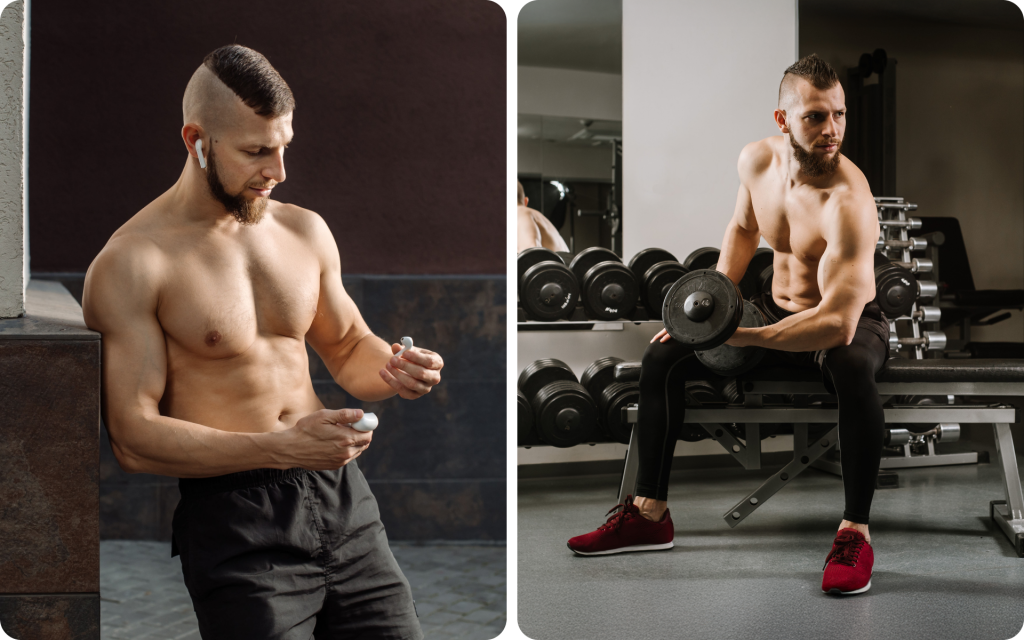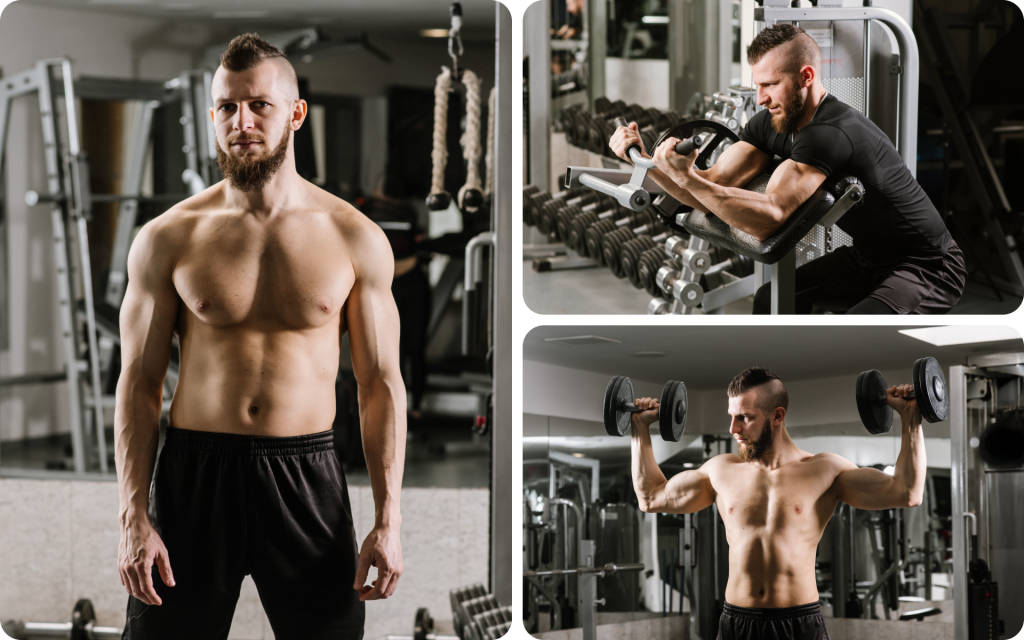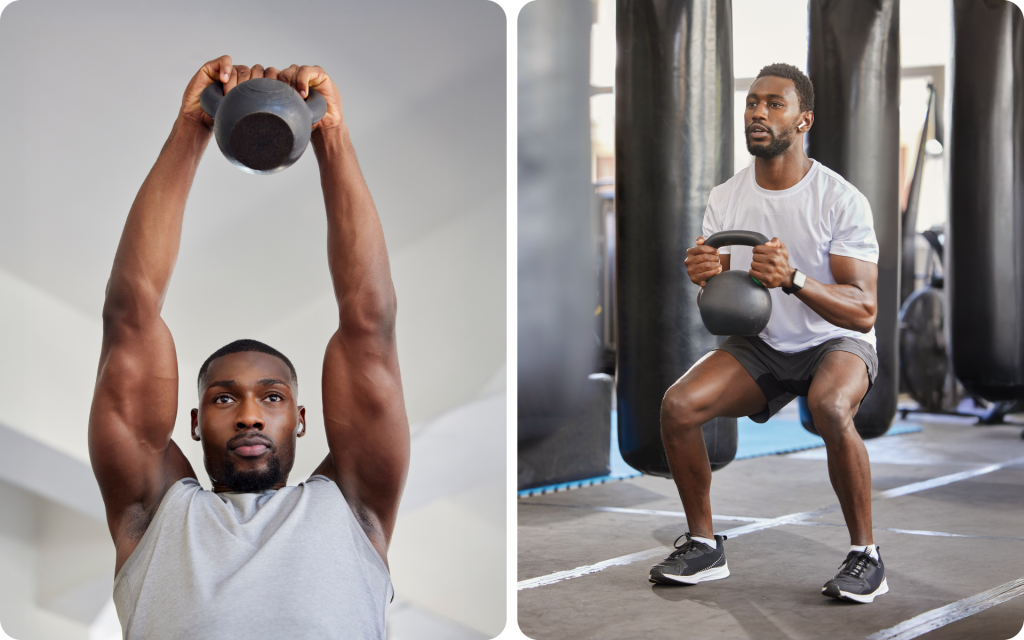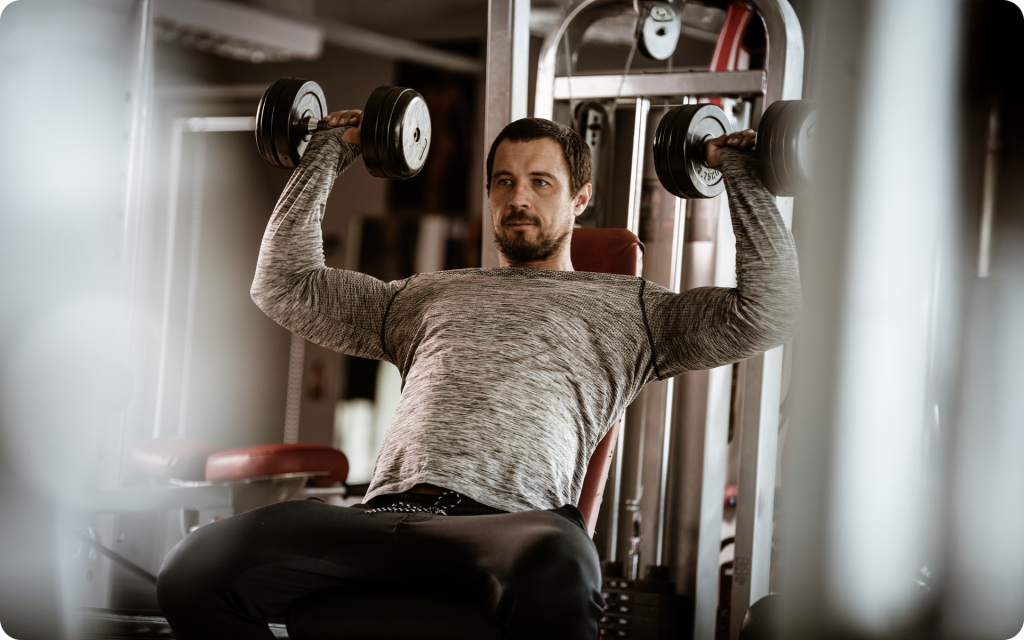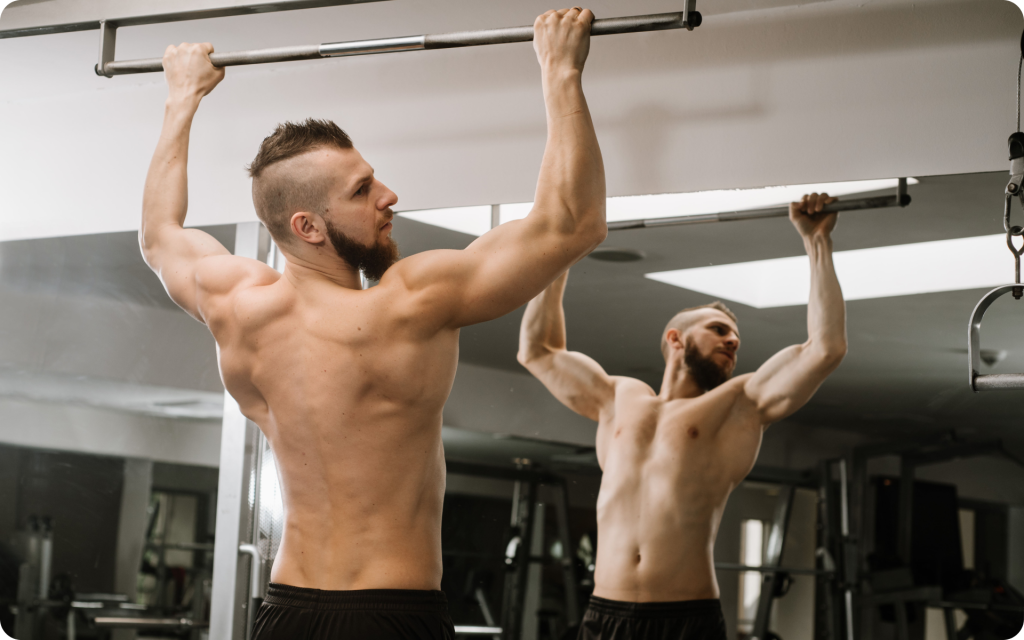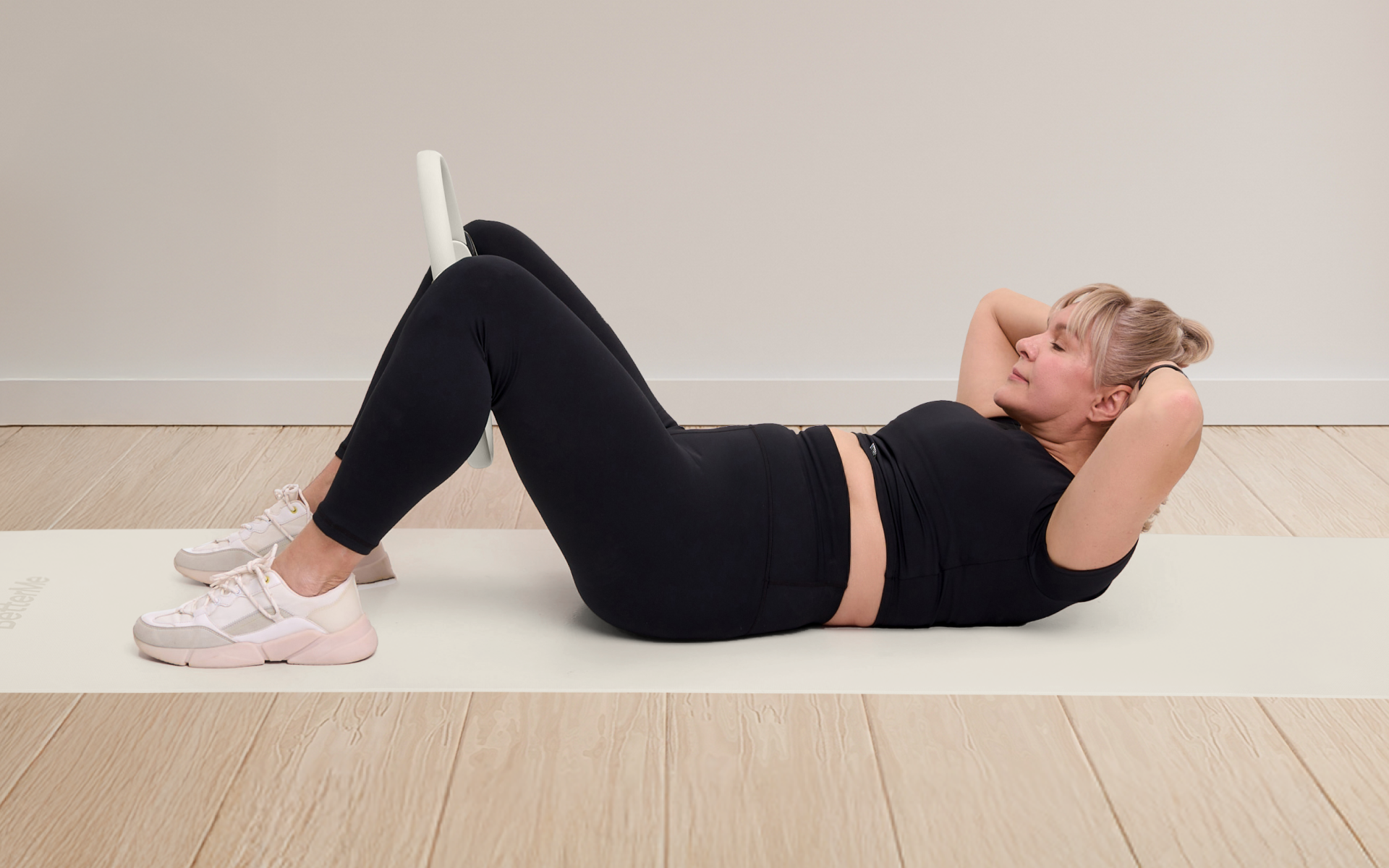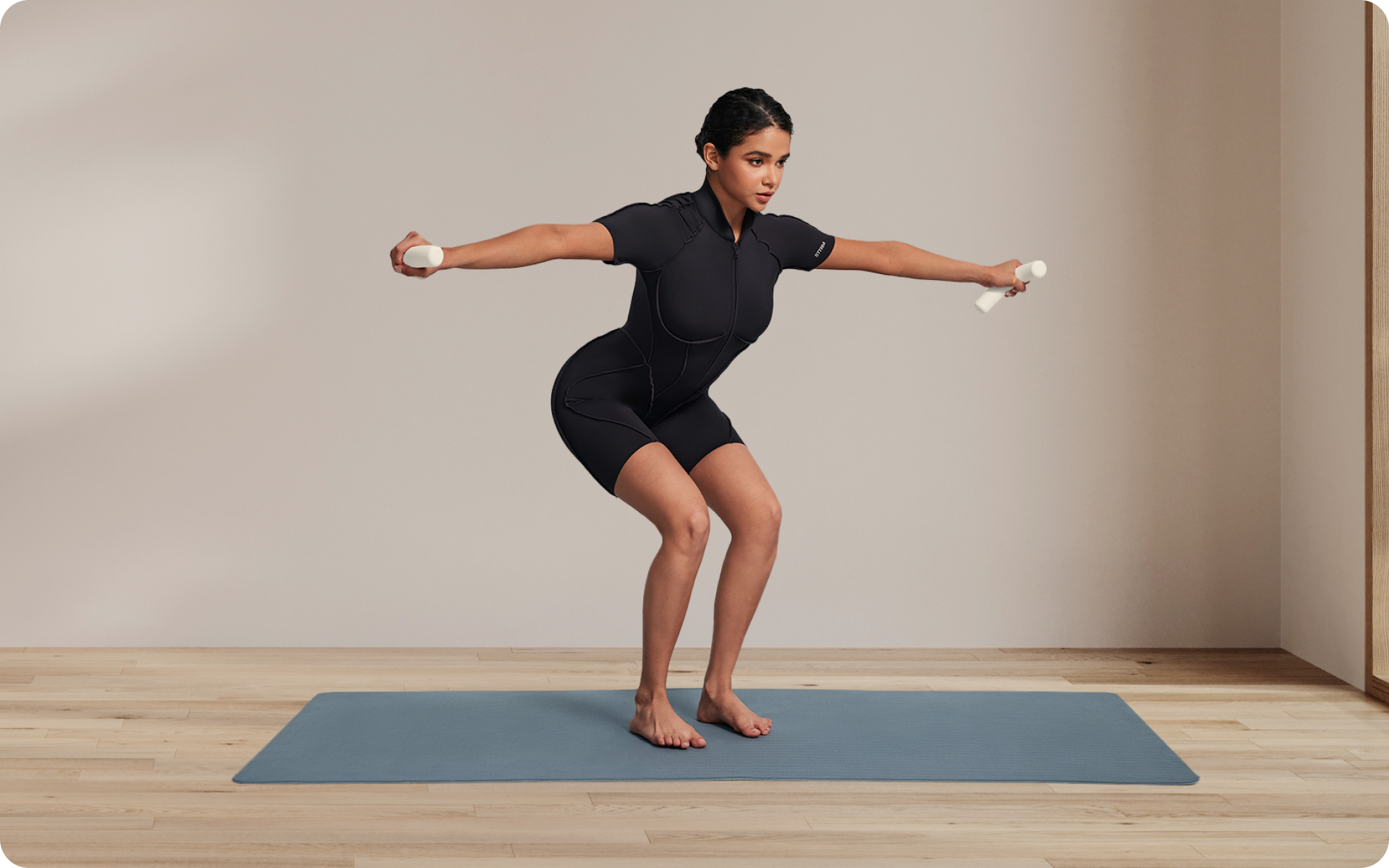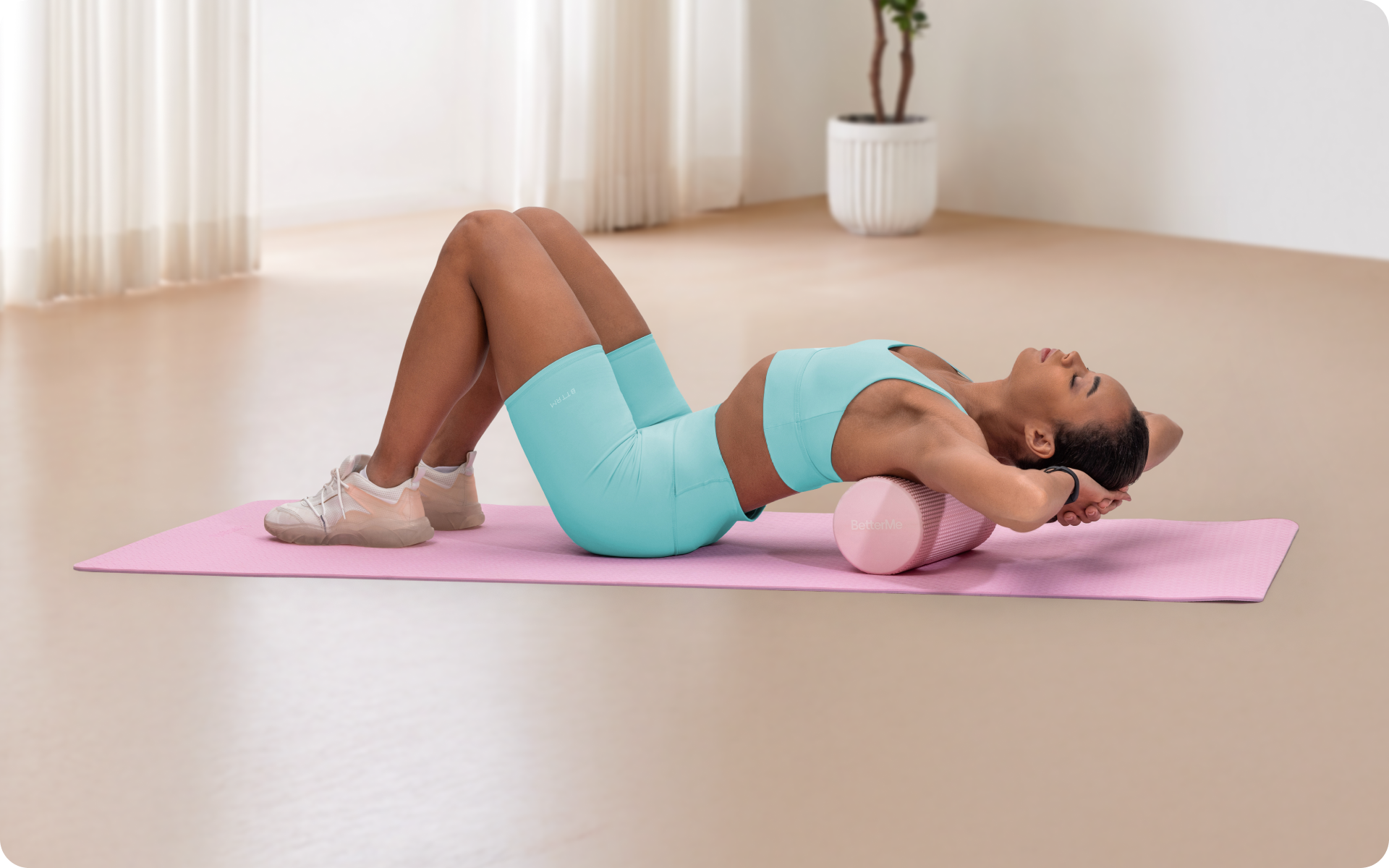Building a powerful, balanced physique doesn’t require spending hours at the gym every day. A well-structured full-body workout for men can deliver impressive results while fitting seamlessly into a busy schedule.
Full-body workouts train all your major muscle groups in a single session using compound movements and targeted isolation exercises. This approach maximizes efficiency, which allows you to stimulate muscle growth, build strength, and improve overall performance in just three sessions per week.
Here’s what beginners should know about full-body gym workouts for men.
Should Men Do Full-Body Workouts?
Yes, full-body workouts are highly effective for men across all experience levels (1, 2).
The benefits translate particularly well for men as this training style capitalizes on natural physiological advantages. Men typically have higher testosterone levels and greater muscle-building potential (3), which means frequent stimulation of all major muscle groups can lead to consistent, measurable gains.
Research has shown that muscles generally see optimal growth when trained twice a week, or three times when the volume is distributed properly (1, 4). Full-body workouts allow you to hit each muscle group multiple times per week while providing adequate recovery between sessions. This frequent stimulus triggers protein synthesis more often than body part splits, such as the bro split (1), where you might only train a muscle group once per week.
For men specifically, full-body training offers several key advantages (5):
- Higher training frequency for all muscle groups (typically 2-3 times per week)
- Increased testosterone response from compound movements such as squats and deadlifts
- Greater total workload per session, which leads to enhanced calorie burn
- Improved movement patterns that translate to athletic performance and injury prevention
- Time efficiency that fits demanding work and life schedules
The compound exercises that form the foundation of full-body workouts – squats, deadlifts, presses, and rows – create a significant hormonal response. These multi-joint movements recruit large amounts of muscle tissue, which research has suggested may support optimal testosterone levels and growth hormone release (6).
For beginners, full-body workouts provide a structured path to learning fundamental movement patterns. For intermediate lifters, they offer continued progress without excessive time commitment. Even advanced athletes use full-body training during certain phases to maintain their strength while managing fatigue. If you’re curious about full-body workout at home without equipment, check out our earlier article.
Read more: The Ultimate 3-Day Workout Plan for Men to Build Muscle and Strength
Is It Better to Do Full-Body Workouts or Splits?
The answer will depend on your experience level, recovery capacity, and training goals (7).
Full-Body Workouts: Pros
- Train each muscle group 2-3 times per week for more frequent growth stimulus
- Shorter total time commitment (3 sessions vs. 5-6 for many splits)
- Better for beginners who are learning movement patterns
- Easier to recover from for most people
- More flexibility if you miss a session (you’ve still trained everything recently)
- Enhanced calorie burn from compound movements in every session
BetterMe: Health Coaching app helps you achieve your body goals with ease and efficiency by helping to choose proper meal plans and effective workouts. Start using our app and you will see good results in a short time.
Full-Body Workouts: Cons
- Sessions can be longer (45-90 minutes)
- May feel more demanding, as you’re training everything each time
- Limited volume per muscle group in any single session
- Can become challenging as you advance and require more total work
Split Routines: Pros
- Allow higher volume per muscle group in a single session
- Shorter individual workouts that are focused on specific areas
- Can feel less fatiguing, as you’re only training certain muscle groups
- May be necessary for advanced lifters who need more total weekly volume
Split Routines: Cons
- Each muscle group is trained less frequently (often just once per week)
- Requires more weekly sessions to match the frequency of full-body training
- Missing a workout means missing that muscle group entirely for the week
- Can lead to overemphasis on certain “mirror muscles” while neglecting others
When Full-Body Workouts Work Best
Full-body workouts are most efficient for beginners and intermediates who can still make consistent progress with moderate volumes (2). If you’re training 3-4 days per week and can recover adequately between sessions, full-body training will likely produce excellent results.
When Splits May Be Better
As you advance beyond the intermediate stage, you may require more total volume to continue progressing. At this point, an upper/lower split (4 days per week) or push/pull/legs split (6 days per week) may become necessary to accumulate enough work per muscle group while managing fatigue (8).
The key principle: use the minimum effective dose. You can start with full-body training and only increase the frequency and split your training when progress stalls despite consistent effort and proper nutrition.
Is It Okay to Do a Full-Body Workout in the Gym?
Absolutely. The gym may actually be the most ideal location for full-body training.
While you can certainly perform effective full-body workouts at home or outdoors, the gym environment offers distinct advantages that enhance your results:
Gyms provide access to barbells, dumbbells, cable machines, and specialized equipment that allow for progressive overload – the gradual increase in weight or resistance that drives strength and muscle gains.
This variety enables you to target muscles from multiple angles and modify exercises based on your individual needs and any mobility limitations.
The compound exercises that form the core of full-body training – squats, deadlifts, rows, and presses – require significant resistance in order to maximize their effectiveness (5). Gyms offer the weight increments and safety equipment (power racks, safety bars) that make heavy lifting both possible and safe.
That being said, full-body training can work in other settings if the gym isn’t accessible. You can perform a full-body workout at home without equipment. The principles remain the same – focus on compound movements, progressive overload, and adequate recovery.
Can You Gain Muscle with Full-Body Gym Workouts?
Yes, you can absolutely gain muscle with full-body gym workouts (2) when they’re properly structured and supported with adequate nutrition.
Muscle growth, or hypertrophy, occurs when three primary mechanisms are triggered: mechanical tension, metabolic stress, and muscle damage (9). Full-body workouts effectively activate all three.
Mechanical tension is the primary driver of muscle growth (10). When you lift heavy weights through a full range of motion, you create tension in the muscle fibers. Full-body workouts that are built around compound movements such as squats, deadlifts, and presses generate significant mechanical tension across multiple muscle groups simultaneously.
The key is progressive overload – gradually increasing the weight, reps, or sets over time (11). As you get stronger and lift heavier loads, you create more mechanical tension, which signals your body to build more muscle tissue to handle the increasing demands.
Research has indicated that training each muscle group 2 times per week produces superior muscle growth compared to once-per-week training (12).
Full-body workouts naturally provide this higher frequency, meaning each muscle receives multiple growth signals throughout the week rather than a single, high-volume assault followed by six days of minimal stimulus.
To capitalize on the muscle-building stimulus from full-body training, you need:
- A caloric surplus (eating more calories than you burn) (13)
- Adequate protein intake (0.7-1.0 grams per pound of body weight daily) (14)
- Protein distributed throughout the day (25-40 grams per meal) (15)
- Quality sleep (7-9 hours per night for optimal recovery) (16)
What Is an Example of a Powerful Full-Body Gym Workout for Men?
Below is a 12-week program that’s designed specifically for men who are looking to build mass and strength efficiently.
This program trains all major muscle groups three times per week, incorporating both heavy compound movements and targeted isolation exercises. It’s structured around progressive overload – gradually increasing the weight you lift – which is the fundamental driver of strength and muscle gains.
Program Structure
You’ll perform three workouts per week (Monday, Wednesday, and Friday) with at least one rest day between sessions. This frequency will allow you to hit each muscle group multiple times weekly while providing adequate recovery.
Monday – Workout A
Wednesday – Workout B
Friday – Workout C
Before we dive into the exercises, you need to understand the following important terms:
- Ramped Sets: You’ll progressively increase weight across your warm-up sets before hitting your working weight. For 5×5 ramped sets:
- Set 1 uses 60% of your working weight
- Set 2 uses 80%
- Sets 3-5 use 100% (your working weight)
- For example, if your working weight is 200 pounds, you’d do 120×5, 160×5, then 200×5 for three sets
- Working Sets: The sets performed at your target weight where the real muscle-building work happens.
- Progressive Overload: Start conservatively with weights you can handle comfortably for the prescribed reps. When an exercise feels manageable, and you can complete all sets with good form, add 5-10 pounds to the bar. This progression drives gains.
Rest Periods
Rest for 2 minutes between sets for major compound lifts (squats, deadlifts, bench press, rows, overhead press). Use 60-90 seconds rest for isolation exercises (curls, extensions, lateral raises) (1).
Workout A
- Deadlifts (ramped) – 3 sets x 5 reps
- Bench press (ramped) – 5 sets x 5 reps
- Romanian deadlift – 2 sets x 8-12 reps
- Upright row – 3 sets x 10 reps
- Skullcrushers – 3 sets x 10 reps
- Dumbbell curls – 3 sets x 10 reps
- Leg curls – 3 sets x 12-15 reps
- Ab wheel roll out – 3 sets x 10-15 reps
Whether you’re a workout beast or just a beginner making your first foray into the world of fitness and dieting – BetterMe has a lot to offer to both newbies and experts! Install the app and experience the versatility first-hand!
Workout B
- Squats (ramped) – 5 sets x 5 reps
- Barbell row (ramped) – 5 sets x 5 reps
- Seated overhead press – 3 sets x 8-10 reps
- Pull-ups or inverted rows – 3 sets x 10-15 reps
- Dips – 3 sets x 10-20 reps
- Barbell shrugs – 3 sets x 10 reps
- Standing or seated calf raise – 3 sets x 12-15 reps
- Plank – 3 sets x 60 seconds
Workout C
- Squats (ramped) – 3 sets x 5 reps
- Incline dumbbell bench press – 3 sets x 10 reps
- One arm dumbbell row – 3 sets x 10-15 reps
- Seated Arnold press – 3 sets x 10-15 reps
- Cable tricep extensions – 3 sets x 10 reps
- Barbell curls – 3 sets x 10 reps
- Leg extensions – 3 sets x 12-15 reps
- Ab wheel roll out – 3 sets x 10-15 reps
For additional workout options, explore our basic full-body workout for simpler equipment needs.
Read more: Compound Lift Workout Plan: 5 Basic Exercises for a Full-Body Workout
What Are the Disadvantages of a Full-Body Gym Workout for Men?
Full-body workouts can feel more demanding than split routines as you’re training all major muscle groups in one session, which requires more recovery time (17). This may lead to longer workouts (45-90 minutes) and greater overall fatigue, particularly for beginners who are still building work capacity. If you’re accustomed to shorter, more focused workouts, the adjustment period may initially feel challenging.
Full-body workouts can accommodate moderate volume effectively, but there’s a practical limit to how much work you can complete for each muscle group in a single session while maintaining quality and recovery.
Advanced lifters who need 15-20+ sets per muscle group per week may find it difficult to distribute this volume across just three full-body sessions without compromising recovery or extending workouts to impractical lengths.
These potential disadvantages don’t make full-body training ineffective. For most men, particularly beginners and intermediates, the benefits far outweigh these considerations. However, understanding these limitations helps you make informed decisions about whether full-body training is aligned with your current goals and circumstances.
Should Gym Beginners Do Full-Body Workouts?
Yes, full-body workouts are ideal for gym beginners.
When you’re new to lifting, your primary goals should be learning proper movement patterns, laying a foundation of strength, and developing the habit of consistent training. Full-body workouts accomplish all three objectives efficiently.
- Movement Pattern Mastery
Beginners benefit from frequent practice of fundamental movements such as squats, hinges, presses, and pulls. By performing these patterns 2-3 times per week rather than once, you accelerate skill acquisition and develop better technique. This frequent practice ingrains proper form, which reduces injury risk and ensures you’re prepared to lift heavier weights safely as you progress (18).
- Optimal Stimulus for Rapid Gains
Beginners respond to training differently from advanced lifters. Your body is highly sensitive to the training stimulus, which means you don’t need enormous volumes to trigger adaptation (19). Full-body workouts provide enough stimulus to drive consistent progress while allowing adequate recovery between sessions.
The “newbie gains” phase – where beginners make rapid progress – is maximized by training each muscle group frequently with moderate volume rather than infrequently with high volume.
- Time Efficiency
Starting a new training program requires building sustainable habits. Three full-body sessions per week are more manageable for most beginners than five or six split routine workouts. This reduced frequency makes it easier to maintain consistency, which is the single most important factor in long-term success.
- Progressive Overload Framework
Full-body programs provide a clear, straightforward progression model. You perform the same exercises multiple times per week, which makes it easy to track progress and add weight systematically. This structured approach takes the guesswork out of training and ensures you’re consistently challenging your muscles.
- When to Consider Transitioning
After 6-12 months of consistent full-body training, you may reach a point where you need more volume per muscle group or prefer a different training structure. At that stage, transitioning to an upper/lower split can be appropriate. However, many lifters continue progressing on full-body routines well into the intermediate stage, so there’s no need to rush the transition.
Check out this resistance bands full-body workout for travel or home training if you’re not ready for gym training just yet.
No, training your full body every day isn’t recommended for most people. Training the same muscle groups daily doesn’t allow adequate time for the recovery process. For most lifters, 48 hours between full-body sessions provides the optimal balance of training frequency and recovery (20). This typically translates to 3-4 full-body workouts per week. Advanced athletes who train full-body daily often use highly specialized programs with carefully managed intensity and volume. They also typically have many years of training experience that has built exceptional recovery capacity (21). This approach isn’t suitable or necessary for most people. You can perform push-ups daily if the volume and intensity are managed appropriately. Push-ups are a relatively low-impact bodyweight exercise that many people can recover from quickly. Daily push-up practice can improve muscular endurance and help maintain strength (22), particularly if you’re not performing them to complete failure each session. However, you should consider these factors: For most people who are following the full-body program outlined above, adding daily push-ups isn’t necessary and may impair recovery from your scheduled bench press and pressing work. Most people who are training with full-body workouts should take 3-4 rest days per week. The standard full-body schedule involves three training days (Monday, Wednesday, and Friday) with four rest days. This provides at least 48 hours between sessions for recovery while maintaining frequent muscle stimulation. Your specific recovery needs depend on several factors: If you feel consistently fatigued, notice your performance declining, or struggle with motivation, you may need additional rest days. Conversely, some individuals with excellent recovery capacity may thrive on four training days per week using an upper/lower split. Active recovery – light activities such as walking, swimming, or yoga – on rest days can support recovery without interfering with adaptation from your training sessions (23, 24). A 30-minute full-body workout can be sufficient if it’s structured efficiently and you’re a beginner, but most people will benefit from 45-60 minute sessions. If you focus primarily on compound movements (squats, deadlifts, presses, rows) and minimize isolation work, you can accomplish meaningful work in 30 minutes. Shorter rest periods (60-90 seconds) allow you to complete more work in less time, although this may compromise the weight you can lift on strength-focused exercises.Frequently Asked Questions
Can I do full-body training every day?
Can I do push-ups every day?
How many rest days do I need a week?
Is a 30-minute full-body workout enough?
The Bottom Line
Full-body workouts offer an efficient, scientifically-backed approach to building muscle and strength. By training all major muscle groups 2-3 times per week, you create frequent growth stimuli while maintaining adequate recovery between sessions.
The program that’s outlined in this guide provides everything you need to start making consistent progress. Focus on perfecting your form on the fundamental compound movements, add weight gradually when the exercises feel manageable, and prioritize recovery through proper nutrition and sleep.
DISCLAIMER:
This article is intended for general informational purposes only and does not serve to address individual circumstances. It is not a substitute for professional advice or help and should not be relied on for making any kind of decision-making. Any action taken as a direct or indirect result of the information in this article is entirely at your own risk and is your sole responsibility.
BetterMe, its content staff, and its medical advisors accept no responsibility for inaccuracies, errors, misstatements, inconsistencies, or omissions and specifically disclaim any liability, loss or risk, personal, professional or otherwise, which may be incurred as a consequence, directly or indirectly, of the use and/or application of any content.
You should always seek the advice of your physician or other qualified health provider with any questions you may have regarding a medical condition or your specific situation. Never disregard professional medical advice or delay seeking it because of BetterMe content. If you suspect or think you may have a medical emergency, call your doctor.
SOURCES:
- Progression Models in Resistance Training for Healthy Adults (2009, journals.lww.com)
- Split or full-body workout routine: which is best to increase muscle strength and hypertrophy? (2021, pmc.ncbi.nlm.nih.gov)
- Testosterone levels positively linked to muscle mass but not strength in adult males aged 20–59 years: a cross-sectional study (2025, frontiersin.org)
- Effects of training frequency on muscular strength for trained men under volume matched conditions (2021, pmc.ncbi.nlm.nih.gov)
- Compound Exercises (n.d., physio-pedia.com)
- Hormonal responses and adaptations to resistance exercise and training (2005, pubmed.ncbi.nlm.nih.gov)
- No Time to Lift? Designing Time-Efficient Training Programs for Strength and Hypertrophy: A Narrative Review (2021, link.springer.com)
- Do Single-Joint Exercises Enhance Functional Fitness? (2012, journals.lww.com)
- The Mechanisms of Muscle Hypertrophy and Their Application to Resistance Training (2010, journals.lww.com)
- Anabolic signals and muscle hypertrophy – Significance for strength training in sports medicine (2025, sciencedirect.com)
- Progressive Overload Explained: Grow Muscle & Strength Today (n.d., blog.nasm.org)
- Effects of Resistance Training Frequency on Measures of Muscle Hypertrophy: A Systematic Review and Meta-Analysis (2016, link.springer.com)
- Is an Energy Surplus Required to Maximize Skeletal Muscle Hypertrophy Associated With Resistance Training (2019, frontiersin.org)
- International Society of Sports Nutrition Position Stand: protein and exercise (2017, jissn.biomedcentral.com)
- How much protein can the body use in a single meal for muscle-building? Implications for daily protein distribution (2022, tandfonline.com)
- Sleep and muscle recovery: endocrinological and molecular basis for a new and promising hypothesis (2011, pubmed.ncbi.nlm.nih.gov)
- Resistance Training Recovery: Considerations For Single Vs. Multi-joint Movements And Upper Vs. Lower Body Muscles (2015, researchgate.net)
- PROGRESSIVE STRATEGIES FOR TEACHING FUNDAMENTAL RESISTANCE TRAINING MOVEMENT PATTERNS (2023, nsca.com)
- Minimalist Training: Is Lower Dosage or Intensity Resistance Training Effective to Improve Physical Fitness? A Narrative Review (2023, link.springer.com)
- Why Rest Days Are Important for Muscle Building (n.d., blog.nasm.org)
- Neuromuscular adaptations to resistance training in elite versus recreational athletes (2025, frontiersin.org)
- The Effects of Push-Up Training on Muscular Strength and Muscular Endurance (2018, researchgate.net)
- A Systematic Review on the Effectiveness of Active Recovery Interventions on Athletic Performance of Professional-, Collegiate-, and Competitive-Level Adult Athletes (2019, journals.lww.com)
- Active Recovery: Reduce Fatigue and Enhance Performance (2020, issaonline.com)


